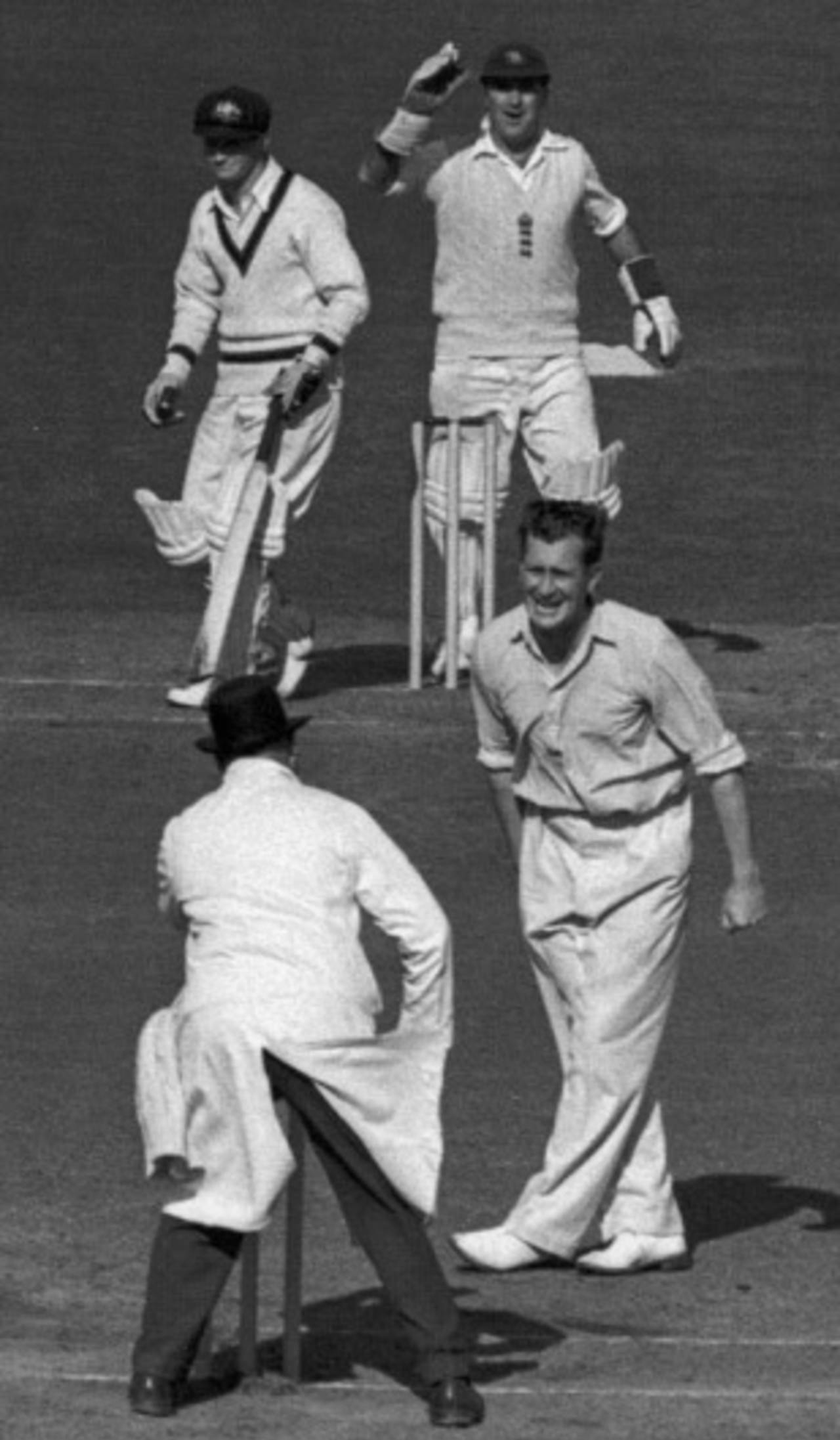The vincible and the untouchable
Records that are vulnerable to the passage of time, and those that are safe forever

Laker's 19 wickets in a Test is among the most secure records in cricket • PA Photos/Getty Images
At Colchester in 1938, the Kent opener, who would umpire more than three times as many Tests as he would bat in (18 to five), dominated the visitors' first innings to such a voracious extent that he accounted for 244 of their 429 runs. Having ensured a lead of 79, he then went out and piled on a further 202 not out in just 170 minutes, becoming the only man in first-class annals ever to rack up a double ton in each innings. Given that first-class fixtures, for all their increasing scarcity, now tend to encompass four days, and such is the helter-skelter rate of modern scoring, it is far from inconceivable that Phil Hughes, to cite but the most obvious candidate, will match Fagg before he is done.
In Kingston in 1930, England ransacked the hapless West Indies wrist-spinner for 374 runs - 266 in the first innings, 108 in the second. Against India last winter, however, Jason Krejza, took 12 wickets on debut but came within 17 runs of annexing arguably the least desirable Test bowling record of all. Given that there have been five other instances of a bowler yielding 268-plus over the past 15 years (Anil Kumble did so twice), who can say how much longer Scott's nadir will stand?
Gregory's mark of 15 has stood since the 1920-21 Ashes encounter, since when Greg Chappell (14 in the 1974-75 Ashes) has come closest, with Bobby Simpson (twice), Brian Lara (twice) and Rahul Dravid all managing 13. You might have thought, with the gradual erosion of the five-Test series, that Gregory was pretty safe. Since the start of 1997, nevertheless, there have been 19 instances of a fielder taking 10 catches or more, including seven in a four-match series, two in three-Test rubbers, and one, by Stephen Fleming, in a two-matcher. Do hold your breath.
Over the past dozen years no fewer than 18 first-up totals of 400-plus have led to defeat, and nine in excess of 440, headed by Australia's 556 against India at Adelaide in 2003-04. Yesterday's surefire insurance is today's opening gambit
Bradman's erstwhile sparring partner notched a hundred in 10 successive first-class matches in 1926-27, three more than Bradman himself managed in 1931-32 and Ernest Tyldesley did in 1926. The best such streak since has been six, by David Boon (on the 1993 Ashes tour), Lara (1993-94) and Jacques Kallis (2003-04), but with time running out on the most prolific first-class career of the modern era, who would bet against Mark Ramprakash trumping Ponny? Given that he set the extant record for most consecutive first-class scores of 150-plus, with five in 2006, certainly not me.
The only significant record to survive an entire century - Australia totted up 586 but still fell prey to the first of only three instances of a side enforcing the follow-on and losing. Over the past dozen years, however, no fewer than 18 first-up totals of 400-plus have led to defeat, and nine in excess of 440, headed by Australia's 556 against India at Adelaide in 2003-04. Yesterday's surefire insurance is today's opening gambit.
Sport's most famous four-figure number - 99.94 - remains more than half as impressive again as the next best. Not even Usain Bolt can claim to be that superior. Every bit as staggeringly breathtaking today as it was in 1948. That first-class average of 95.14 (nobody else has contrived a mean of 72) isn't too shabby either.
Nineteen wickets. In a Test to boot. Nobody else in first-class history has ever taken 18 - unless, that is, one counts Henry Arkwright, who recorded 18-96 for Gentlemen of MCC v Gentlemen of Kent in a 12-a-side match in 1861, and Frederick Lilywhite, about whose feat for the Players against the 16-man Gents at Lord's in 1837 not even the number of runs conceded is known. Since that magical week at Old Trafford in 1956, moreover, only John Davison, for Canada against the USA in 2004, has reaped 17. It's a toss-up as to whether 99.94 or 19 for 90 is the most fabulous figure in cricket annals - what is it about the number nine? Maybe The Beatles had something?

At Lancaster Park, Christchurch, on the last day of February, 1914, Victor Trumper, batting at a lowly No. 9 in the Australians' order, came in to join Arthur Sims with the tourists having struggled to 209 for 7 in response to Canterbury's 92 all out. By the time Trumper was caught for 293, the eighth-wicket pair had added 433 in a shade over three hours of controlled mayhem. Only one partnership for the eighth wicket has ever come within 140 runs of that seemingly impregnable zenith: 313 by Wasim Akram and Saqlain Mushtaq for Pakistan against Zimbabwe in 1996-97.
Again, scoring rates may possibly render this vincible, but concentration spans will probably ensure it isn't. Consider this: behind Bradman's 37 stands Hammond, with 36, but Patsy Hendren (22) is the only other batsman to have managed more than 17. Of the moderns, Graeme Hick (16) and Ramprakash (15) stand tallest.
Opportunity has something to do with it, yes. Of the eight instances of a bowler taking 40 or more wickets in a single rubber, all bar one have required at least five Tests, and four needed six. The remarkable exception, though, is Barnes, whose 49 South African scalps at 10.93 apiece in 1913-14 encompassed just four matches. The tragedy with Barnes is that there is no footage of him at his awesome, unprecedented peak. For once, we simply have to take genius on trust.
Rob Steen is a sportswriter and senior lecturer in sports journalism at the University of Brighton